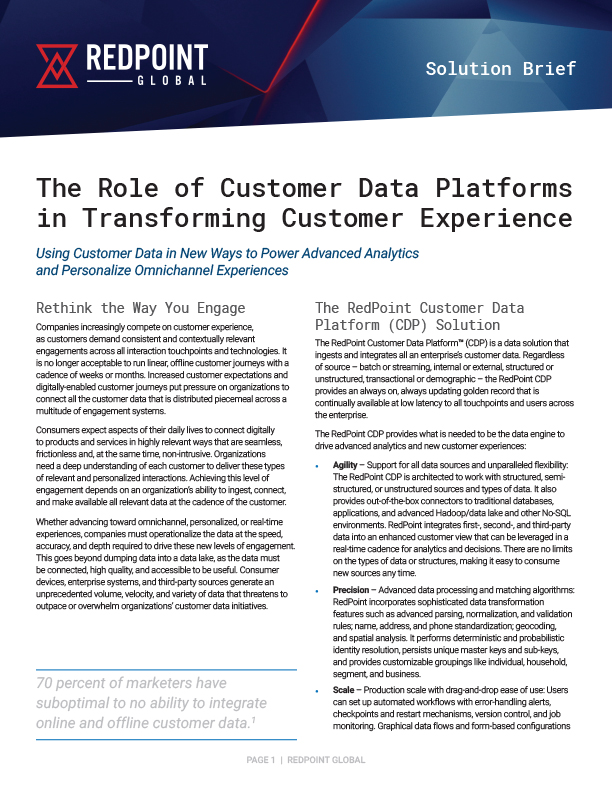 In the race to personalize the customer experience, marketers who work with siloed data in traditional relational database management systems (RDBMS) have become practiced in hedging their bets. Knowing that a marketing program set to run in the morning may be irrelevant to a small cohort if data has yet to refresh, they will be intentionally vague with their message and send broadly personalized info based on segments. With this model, they are betting that there will be more conversions with this vague message than the number of intended targets frustrated by receiving an irrelevant message or offer (e.g. a discount on an item they recently purchased).
In the race to personalize the customer experience, marketers who work with siloed data in traditional relational database management systems (RDBMS) have become practiced in hedging their bets. Knowing that a marketing program set to run in the morning may be irrelevant to a small cohort if data has yet to refresh, they will be intentionally vague with their message and send broadly personalized info based on segments. With this model, they are betting that there will be more conversions with this vague message than the number of intended targets frustrated by receiving an irrelevant message or offer (e.g. a discount on an item they recently purchased).
The problem with this approach is that vague messages do not move the needle for customers, who now more than ever before expect to be recognized and treated as an individual. For marketers, delivering a hyper-personalized customer experience in line with customer expectations requires keeping pace with an always-on consumer. It requires meeting the customer at every touchpoint of an omnichannel journey, on any device, and in the precise context and cadence.
Intentionally vague messaging may have sufficed just a few years ago, but today’s sophisticated customer easily sees through the gambit and will react to impersonal or, worse, irrelevant messages by taking their business to a competitor that offers the personalization they expect. In a recent Marketing Insider Group survey, 78 percent of consumers reported that personally, relevant content increases their intent to purchase.
A NoSQL (Not Only SQL) document database transcends the limitations of an RDBMS that have prevented marketers from providing customers with personalization at the speed and scale necessary to deliver a real-time, dynamic customer experience across channels and devices.
I will present a session about NoSQL databases at TRANSCEND19, Redpoint Global’s second customer conference, April 3-5 in Boston. During our session, “Use Cases and Practical Applications for NoSQL and Document Databases” (April 4, 10:30 a.m.), we will explore how the maturation of database technologies meshes perfectly with the marketing trend toward personalization, how a NoSQL document database delivers value and the key document database use cases for marketers using Redpoint Data Management (DM) or Red Point Integration (RPI) to unify inbound and outbound marketing with a NoSQL document database.
Marketing Transformation with Data Consolidation
While NoSQL databases were largely created to satisfy global distribution requirements, marketers quickly realized that the schema-less, unstructured data formats that NoSQL databases support could transform database marketing with significant performance increases.
Specific to document databases, a major benefit of NoSQL is data consolidation; by having all customer data available in a single document and accessed without impacting other applications using the same database eliminates any practical need to have siloed data, eliminating the ETL constraints that introduced lag and prevented marketers from real-time customer engagements with the most recent data.
Data consolidation enabled by a NoSQL document database allows marketers to achieve operational use cases such as personalization, a 360-degree customer view, and profile management with far greater confidence in the data.
Not having to move data around strips away complexity, freeing marketers from having to work with raw data and build queries to create effective marketing programs. Further, a NoSQL document database gives marketers the confidence that any data they need is in the document at the time it’s needed. A segment out of a database, therefore, is guaranteed to be valid at the time of execution, eliminating the fudging and vagueness used to prop up a program that relies on siloed (read: old) data.
Trust in marketing programs is solidified because the structure and hierarchy of a document in a document database is known to a marketer. If, for example, a marketer wants to know everyone who has purchased a certain product, any piece of relevant data in existence will be in the document, inspiring confidence in the result. With a SQL database, this might not be the case; a marketer building a query might misplace a command, skew the results, and inadvertently create a campaign marred by irrelevant messages.
There are also many IT benefits of a NoSQL document database – a significant cost benefit with everything pushed into a single database and global distribution among them – but our TRANSCEND19 session will focus largely on NoSQL supporting marketers using Redpoint solutions to create personalized engagements in the context and cadence of the customer.
A Confluence of Trends Gives Marketers Strategic Control
Database technology is evolving in tandem with the maturation of marketing platforms and programs. Seasoned marketers may recognize a little bit of an old-school approach in how NoSQL document databases alter their day-to-day responsibilities. Roughly 20 years ago, SQL database technology was a basis for giving marketers more control over raw data; marketers had control over what they wanted to build based on the schema. But personalization requirements and the massive amounts of data that marketers must work with render this control almost meaningless, like a finger in a dike.
A document database takes back some of the control with marketing requests pre-built by data scientists into a document, meaning the operational marketer only has to click on a drop-down to find what they need. At first glance, an outside view might be that this strips marketers of not just control, but strategic value. But the opposite is true; document database marketing allows marketers to be even more strategic by creating last-mile, segment-of-one engagements and letting machine learning and advanced analytics do the heavy lifting to activate the data.
A pre-built document – a one-sheet for your customer – is more in line with marketing objectives than working off a schema because it values recency over volume. Aggregates that use archived data, sentiment, or anything that exists outside the document can be baked into machine learning algorithms. Just as a marketer doesn’t have to worry about where data is stored, they don’t have to worry about ranking data values, or constructing models. The data they need is at their fingertips; while a document database may strip them of control of raw data, it makes up for it in spades by giving marketers strategic control over how data is used to create a differentiated customer experience.
Learn More at TRANSCEND19
While a NoSQL document database has the potential to transform marketing operations, there is still ample room for a database platform with both NoSQL and SQL technologies. A relational database certainly meets a purpose for many use cases and data sets, and is a workhorse known for consistency, availability, and for handling well-defined, rarely changed schema. Introducing NoSQL into your architecture does not have to be an all-in proposition; many organizations explore hybrid implementations that optimize unique outcomes. We will discuss hybrid implementations during our TRANSCEND19 session.
Customers who are accustomed to running database marketing on SQL may have concerns about adopting an unstructured DB. Redpoint makes the process of managing this data seamless – allowing people familiar with SQL to navigate a NoSQL tool without requiring a deep understanding of tables, keys, or transaction joins.
This straightforward process lowers the entry barrier for many customers, even though in some cases there is still a short learning curve for those more familiar with schema formats. Any learning curve, however, must be measured by the transformative benefits of running Redpoint solutions on top of a NoSQL database. In a recent Veritas report, “Realizing the Power of Enterprise Data” that polled 1,500 IT decision makers, 40 percent said that having too many different data management systems in use poses their biggest challenge, with 38 percent saying they have too many data sources to make sense of.
A NoSQL database at the core of a database marketing strategy significantly mitigates these concerns. Register for TRANSCEND19 today, and find out why nearly 90 percent of respondents in a recent customer survey said that NoSQL is either “important” or “critical” to their business.
RELATED ARTICLES
Art of the Possible – The Role Data Can Play in Unlocking Marketing Creativity
Introducing the Next Generation of the Redpoint Customer Engagement Hub
A New Way for Marketers to Leverage Data for Omnichannel Marketing

